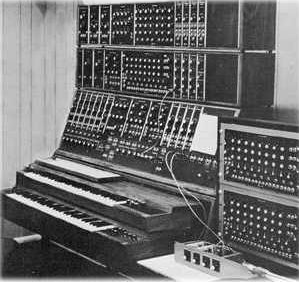Beyond the Barline
And the Award Goes to…
Apple Computer! But you probably knew that already. On Tuesday, February 26 (one night before the actual awards show) Apple received a Technical Award for Lifetime Achievement from the National Academy of Recording Arts and Sciences. So maybe the Grammy means something after all. Maybe Homer Simpson was hasty in trying to give his award to a waiter in lieu of a tip. After all, in pioneering a user-friendly personal computer, Apple was a huge contributor to digital music revolution of the 80s and 90s.
But my column isn’t about Apple’s award. Instead, it’s about the other award given that night: an award given to an individual who helped pioneer the analog music revolution which set the stage for Apple, MIDI, and all those software companies that arose in the 80s. Over a decade before the Steves gave us the first Apple—and almost two decades before the Mac, MIDI, and the software sequencer brought about the digital music revolution—the voltage controlled synthesizer was born, thanks in part to the other award winner.
And the Award Goes to…
Robert Moog, the inventor of the Moog Synthesizer. Though Moog was not solely responsible for the development of the voltage-controlled synthesizer (Don Buchla’s Buchla 100 and Paolo Ketoff’s Syn-Ket, also developed in the mid-60s, were contemporaries), the Moog Synth was the most influential on subsequent development.
The State of the Art, Circa 1960
The RCA Mark II was the first self-contained analog synthesizer. Like computers of the day, it filled an entire room and read data off punch cards (well actually a punch roll, but the idea was the same). It cost $100,000 in its day, and was anything but user-friendly. The demand was growing among composers (synths were not yet a part of pop music) for a system that was self-contained (rather than assembled ad hoc out of various electronic components), flexible, and affordable. Moog’s solution, one of the first modular synthesizers, was one tenth the price of the Mark II.

A Moog Modular Synth (1967)
What’s So Hip About Mod?
Modular synthesizers are both flexible and expandable. Components aren’t hard-wired. Instead, the user must “patch” the synth with patch cords (the term “patch” is still used on today’s digital instruments) to get the desired sound. The user can also add components as desired. Modularity was shared by both the Moog and Buchla synths, while the Syn-Ket was hard-wired. What the Moog Synth had that the Buchla 100 didn’t, though, was a keyboard. Yes, I’m sure some of you are wondering what use a synth is without a keyboard. Honestly, though, the choice of a keyboard as a controller is purely a practical one, since a keyboard is basically a set of switches in a very familiar pattern. Buchla was philosophically opposed to keyboards, believing that a new instrument should have a new interface. Otherwise, he feared, the synth would just become another electric organ. His fears, as it turns out, were totally justified.
The Reasons for Moog’s Success
First, the Moog Synth was a perfect compromise between the Syn-Ket, which, with a keyboard but no modularity was geared solely toward performance, and the Buchla 100, which, with modularity, but no keyboard, was geared solely toward the studio. The first Moog Synth was certainly too big and too expensive to go on the road, but Moog’s decisions regarding its design paved the way for the very popular and very affordable Mini-Moog, his most successful instrument. Secondly, the first best-selling electronic music record, Walter (now Wendy) Carlos’ Switched on Bach (1969), popularized synths in general and the Moog in particular. Within a few years, many of the “art rock” groups (Pink Floyd, Yes, ELP, Tangerine Dream, etc.) had synths.
But it Didn’t Last
Bigger companies like ARP, Roland, Oberheim, and Sequential Circuits rose up to meet the huge demand, and Moog got out of the synth business completely by the end of the 1970s. He returned to his first passion, the Theremin, an instrument so weird and wonderful, it deserves its own column. His present company, Big Briar, sells Theremins (both pre-built and kits), analog effect pedals (under the moogerfooger brand), and Theremin and Moog related gifts.
On the Shoulders of Giants
So congratulations to Apple Computer and to Robert Moog. Without them, I, and many others like me, wouldn’t have the opportunities to create electronic music in homes, schools, and studios. To paraphrase Issac Newton, I only saw so far because I stood on the shoulders of giants.
Also in This Series
- Ready or Not! · November 2002
- The Other Petition · August 2002
- The Samples Have Been Changed to Protect the Innocent · May 2002
- Record Execs Ate My Hard Drive! · April 2002
- And the Award Goes to… · March 2002
- Expos, From a Distance · February 2002
- My Resolution · January 2002
- Too Much Hype · November 2001
- And They’re Off! · September 2001
- Complete Archive
Reader Comments (0)
Add A Comment